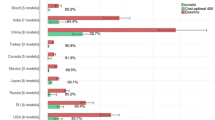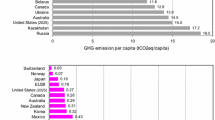Abstract
In this paper, the BASIC (Brazil, South Africa, India, and China) countries, which play an increasingly significant role in combating climate change, are selected as the research objects. First, we investigate the driving factors of the evolution of carbon emissions in the BASIC group from 2000 to 2016. Second, we use the Monte Carlo simulation to analyze the potential evolution trend of carbon emissions in the benchmark scenario, optimization scenario, and enhanced scenario in the BASIC group from 2017 to 2030 to judge whether the countries can achieve their own autonomous contribution goals. Third, we evaluate whether the BASIC INDC can provide practical support for making the global temperature control goals described in the Paris Agreement. The results show that first, the contribution rate of the energy consumption structure and population size to the carbon emissions of the BASIC are low, and the contributions of R&D efficiency, R&D intensity, and investment intensity to the carbon emission change in the BASIC group are more prominent. Second, under the benchmark scenario, Brazil, South Africa, India, and China from the difference between the complete INDC targets respectively is 265.50 Mt, 207.86 Mt, 1034.70 Mt, and 4660.82 Mt. Under the optimization scenario, China could meet the INDC goals. The gap between Brazil, South Africa, and India is 60.06 Mt, 9.50 Mt, and 413.74 Mt, respectively. Under the enhanced scenario, China and South Africa could meet the INDC target, while Brazil and India are 15.69 Mt and 228.28 Mt away from the INDC target, respectively. Third, although the INDC goals of Brazil and India can achieve the carbon reduction allocated under the 2 °C targets, the INDC targets submitted by the BASIC are not enough to reach the carbon reduction allocated under the global 1.5 °C destination; Brazil, South Africa, India, and China’s gap is 64.14 Mt, 246.15 Mt, 236.84 Mt, 3399.64 Mt, respectively. Fourth, Brazil, South Africa, and China should increase its R&D on energy-saving and emission reduction technologies, and India should develop reasonable population policies and green economic development policies.






Similar content being viewed by others
Data availability
All data generated or analyzed during this study are included in the submitted article.
References
Ang BW (2004) Decomposition analysis for policy mark ting in energy: which is the preferred method? J Energy Policy (6)
Asongu S, El Montasser G, Toumi H (2016) Testing the relationships between energy consumption, CO2emissions, and economic growth in 24 African countries: a panel ARDL approach[J]. Environ Sci Pollut Res 23(7):6563–6573
Baer P, Athanasiou T, Kartha S, Kemp-Benedict E (2009) Greenhouse development rights: a proposal for a fair global climate treaty. Ethics Place Environ 12(3):267–281
Blanchard O, Criqui P, Trommetter M et al (2001) Equity and efficiency in climate change negotiations: a scenario for world emission entitlements by 2030 [R]. Université Pierre Mendès France
BP world energy statistical yearbook 2018
Canadell JG, Le Quéré C, Raupach MR et al (2007) Contributions to accelerating atmospheric CO2 growth from economic activity, carbon intensity, and efficiency of natural sink. Proc Natl Acad Sci U S A 104:18866–18870
Carbon Dioxide Information Analysis Center (CDIAC) (2008) Global, Regional, and National Fossil Fuel CO2 Emissions. http://cdiac.ornl.gov (Network database)
Chai Q, Tian C, Gao X, Xu H (2015) Comparative study on cooperation mechanism and low-carbon development model of basic countries. Comp Econ Soc Syst 03:106–114
Chen J, Wang P, Cui L, Huang S, Song M (2018) Decomposition and decoupling analysis of CO2 emissions in OECD. Appl Energy 231:937–950 ISSN 0306-2619
Congregado E, Feria-Gallardo J, Golpe A et al (2016) The environmental Kuznets curve and CO2 emissions in the USA: is the relationship between GDP and CO2 emissions time varying? Evidence across economic sectors[J]. Environ Sci Pollut Res 23(18):18407–18420
Cui X, Wang K, Fu S, Zou J (2017) Global carbon budget and emission path under 2 °C and 1.5 °C targets. China Environ Sci 37(11):4353–4362
Cui X, Wang K, Zou J (2016) Assessment of the intensity and fairness of the goal of “national autonomous contribution” in the US, Europe and China. Environ Sci China 36(12):3831–3840
Den Elzen M, Höhne N (2010) Sharing the reduction effort to limit global warming to 2 °C. Clim Pol 10(3):247–260
Deng J, Liu X, Wang Z (2014) Analysis and factor decomposition of regional differences and evolution characteristics of carbon emissions in China. Nat Resour J 29(02):189–200
Ding Z, Duan X, Ge Q, Zhang Z (2009) Atmospheric CO_2 concentration control in 2050: national emission rights calculation. Sci China (Ser D: Earth Sci) 39(08):1009–1027
Dong C, Dong X, Jiang QZ, Dong KY, Liu GX (2018) What is the probability of achieving the carbon dioxide emission targets of the Paris Agreement? Evidence from the top ten emitters. Sci Total Environ 622–623:1294–1303
Farhani S, Ozturk I (2015) Causal relationship between CO2 emissions, real GDP, energy consumption, financial development, trade openness, and urbanization in Tunisia. Environ Sci Pollut Res 22(20):15663–15676
Feng D, Yang Q, Long R et al (2015) Decomposition and dynamic simulation of carbon emissions in China [J]. China Population, Resources and Environment 25(4):1–8
Fernández González P, Landajo M, Presno MJ (2014) Tracking European Union CO2 emissions through LMDI (logarithmic mean Divisia index) decomposition. The activity revaluation approach. Energy 73:741–750
Fu Y (2016) Thoughts on deepening the cooperation among the basic countries. Modern Int Relat (04):56–62+64
Fujii H, Managi S (2015) Optimal production resource reallocation for CO2 emissions reduction in manufacturing sectors. Glob Environ Chang, MPRA Paper 35:505–513
Guan D et al (2008) The drivers of Chinese CO2 emissions from 1980 to 2030. Glob Environ Chang 18.4:626–634
Höhne N, den Elzen M, Escalante D (2014) Regional GHG reduction targets based on effort sharing: a comparison of studies [J]. Clim Pol 14(1):122–147
http://unfccc.int/process/the-paris-agreement/nationally-determined-contributions
IEA (2016) CO2 Emissions from fuel combustion-highlights. IEA, Paris
IEA (2018) CO2 emissions from fuel combustion-highlights. IEA, Paris
Jordan AJ, Huitema D, Hildén M, van Asselt H, Rayner TJ, Schoenefeld JJ, Tosun J, Forster J, Boasson EL (2015) Emergence of polycentric climate governance and its future prospects. Nat Clim Chang 5:977–982
Kverndokk S (1995) Tradable CO2 emission permits: initial distribution as a justice problem. Environmental Values 4:29–48
Li GZ, Li Z (2011) Empirical analysis of determinants of carbon dioxide emissions: based on panel data from 70 countries (regions). Math Stat Manag 30(04):585–593. https://doi.org/10.1016/j.energy.2014.06.078
Li K, Ruxiao G (2012) The impact of technological progress on carbon emissions —— an empirical study based on interprovincial dynamic panel. J Beijing Norm Univ (Soc Sci Ed) 05:129–139
Lin B, Liu X (2010) Carbon emissions in China’s urbanization stage _ influencing factors and emission reduction strategies _ Lin boqiang. Econ Res volume missing(8):66–78
Liobikienė G, Butkus M, Bernatonienė J (2016) Drivers of greenhouse gas emissions in the Baltic states: decomposition analysis related to the implementation of Europe 2020 strategy. Renew Sust Energ Rev 54:309–317
Matthews HD, Gillett NP, Stott PA, Zickfeld K (2009) The proportionality of global warming to cumulative carbon emissions. Nature 459(7248):829–832
Meinshausen M, Meinshausen N, Hare W, Raper SCB, Frieler K, Knutti R, Frame DJ, Allen MR (2009) Greenhouse-gas emission targets for limiting global warming to 2 °C. Nature 458(7242):1158–1162
Meng Y, Cheng R, Black S (2013) Structural effects and effect decomposition of carbon emissions. Stat Res 30(04):76–83
Meyer A (2000) Contraction & convergence: the global solution to climate change. Green Books
Myles RA, Frame DJ, Huntingford C et al (2009) Warning caused by cumulative carbon emissions towards the trillionth tone. Nature 458:1163–1166
OECD (1974) Recommendation of the council of 14th November 1974 on the implementation of the polluter pays principle [EB/OL]. Organisation for Economic Co-operation and Development, Paris [2018-04-02]
Ostrom E (2012) Nested externalities and polycentric institutions: must we wait for global solutions to climate change before taking actions at other scales? Econ. Theory 49:353–369
Pang J, Wen X, Sun X (2016) Mixing ratio and carbon isotopic composition investigation of atmospheric CO2 in Beijing, China[J]. Sci Total Environ 539:322–330
Ramírez A, Keizer CD, Sluijs JPVD et al (2008) Monte Carlo analysis of uncertainties in the Netherlands greenhouse gas emission inventory for 1990–2004. Atmos Environ 42(35):8263–8272
Raupach MR, Davis SJ, Peters GP et al (2014) Sharing a quota on cumulative carbon emissions. Nat Clim Chang 4(10):873–879
Rogelj J, den Elzen M, Höhne N, Fransen T, Fekete H, Winkler H, Schaeffer R, Sha F, Riahi K, Meinshausen M (2016) Paris Agreement climate proposals need a boost to keep warming well below 2 °C. Nature 534(7609):631–639
Rogelj J, Luderer G, Pietzker RC et al (2015) Energy system transformations for limiting end-of-century warming to below 1.5 °C. Nat Clim Chang 5(6):519–527
Shao S, Zhang X, Zhao X (2017) Empirical decomposition and peak-reaching path of carbon emission in China’s manufacturing industry -- generalized di index decomposition and dynamic scenario analysis. China’s Ind Econ 03:44–63
Sheehan P, Jones RN, Jolley A et al (2008) Climate change and the new world economy: implications for the nature and timing of policy responses. Glob Environ Chang 18(3):380–396
Tobin P, Schmidt NM, Tosun J, Burns C (2018) Mapping states’ Paris climate pledges: analysing targets and groups at COP 21. Glob Environ Chang 48:11–21
Trenberth KE (1981) Seasonal variations in global sea level pressure and the total mass of the atmosphere. J Geophys Res 86:5238–5246
UNEP (2016) The Emissions Gap Report 2016 [R]. Nairobi, United Nations Environment Programme (UNEP)
UNFCCC. FCCC/CP/2015/7: Synthesis report on the aggregate effect of the intended nationally determined contributions [EB/OL]
UNFCCC. Decision 1/CP.21: Adoption of the Paris Agreement
Wang Y, Duan F, Ma X, He L (2019) Carbon emissions efficiency in China: key facts from regional and industrial sector. J Cleaner Prod 206:850–869 ISSN 0959-6526
Wang T, Su M, Xu H et al (2014) China Energy 36(10):22–26
Wang L, Yang L, Chen W, Shan B, Zhang C, Yin S (2018) Evaluation of emission reduction intensity of nationally determined contribution. Prog Clim Chang Res 14(06):613–620
Winkler H, Letete T, Marquard A (2013) Equitable access to sustainable development: operationalizing key criteria. Clim Pol 13(4):411–432
Xie J (2017) Effects of technological advances on carbon emissions. Hunan University
Yang Z (2011) A study on the dynamic relationship between economic growth, energy consumption and carbon dioxide emissions. World Econ 34(06):100–125
Yang Z, Luo H, Xue J, Zhang B (2016) Comparative study on carbon emission situation and targets of China and India. Prog Earth Sci 31(07):764–773
Young HP, Wolf A (1992) Global warming negotiations: does fairness count? [C]//The Brookings review 10. Brookings Institution Press, Washington, DC
Zhang X, Zhao X, Jiang Z, Shao S (2017) How to achieve the 2030 CO2 emission-reduction targets for China;s industrial sector: retrospective decomposition and prospective trajectories. Glob Environ Chang, Pages 44:83–97
Zhu S (2013) Comparison of basic conditions for basic countries to cope with climate change. Rep Open 06:52–55
Funding
This paper is supported by the National Social Science Foundation of China (19CTJ008), Xingliao Talent Program (XLYC1907012), Research Project on Economic and Social Development of Liaoning Province (2020lslktyb-036), Research Project of Liaoning Education Department (LN2019Q48), and National Natural Science Foundation of China (71573034, 71872033).
Author information
Authors and Affiliations
Contributions
Yong Wang and Huijun Wang were mainly responsible for the writing of the full text. Lin Qi built the models of the paper.
Corresponding author
Ethics declarations
Conflict of interest
The authors declare that they have no conflict of interest.
Ethical approval
Not applicable.
Consent to participate
Not applicable.
Consent to publish
Not applicable.
Additional information
Responsible Editor: Philippe Garrigues
Publisher’s note
Springer Nature remains neutral with regard to jurisdictional claims in published maps and institutional affiliations.
Appendices
Appendix 1
Appendix 2
Appendix 3
Rights and permissions
About this article
Cite this article
Wang, H., Wang, Y. & Qi, L. Evaluation of emission reduction targets contributed by BASIC countries from the perspective of global temperature control targets. Environ Sci Pollut Res 28, 6843–6865 (2021). https://doi.org/10.1007/s11356-020-10860-7
Received:
Accepted:
Published:
Issue Date:
DOI: https://doi.org/10.1007/s11356-020-10860-7




